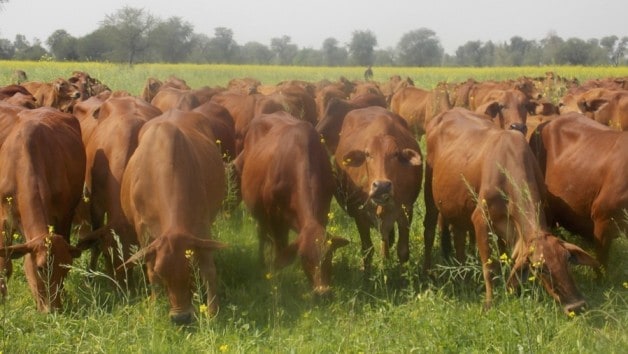
Energy Requirements In Dairy Cows
(The Standard Values have been Obtained From: Feeding Dairy Cows, A Manual for use in the Target Nutrition Program, Edited by Jacobs and Ann Hargreaves, 3rd Edition)
The feed is the source of energy and energy is required to maintain the body functions, such as metabolism, fertility, milk production. There are functions that are essential to the body’s survival and the few that are ancillary. The cow’s body is capable of deciding on the priority for energy partitioning. The top priority is for survival that is the maintenance of physiological functions followed by ancillary functions such as milk production and breeding. The energy currency in the body is adenosine tri-phosphate (ATP), which is synthesized when a feed is metabolized. When excess energy is there it is stored in the form of fat, proteins or carbohydrates which is then used in synthesizing ATP for metabolic functions.
Table 1: Energy Requirements in Dairy Cows for Maintenance |
||
| Weight (Kg) | Energy Requirement MJ / day | Remarks |
| 100 | 17 | Calf between 6-9 months |
| 150 | 22 | Heifer Phase |
| 200 | 27 | |
| 250 | 31 | |
| 300 | 36 | Pregnant heifer phase |
| 350 | 40 | |
| 400 | 45 | Typical Jersey Cows and crossbreds |
| 450 | 49 | |
| 500 | 54 | Typical HF Cows and crossbred |
| 550 | 59 | |
| 600 | 63 | |
Table 2: Average Daily Energy Requirements in the Last Four Months of Pregnancy in Cows and Buffaloes |
|
| Month of pregnancy | Additional energy MJ/day |
| Sixth | 8 |
| Seventh | 10 |
| Eighth | 15 |
| Ninth | 20 |
Understanding how much energy a cow of different physiological functions need is therefore a basic knowledge of the farmers and veterinary service providers. Energy is measured using different units. Gross energy means when a feed is burnt the energy it will release. But gross energy gives a misleading measure as all the gross energy might not be available as some compounds in the feed cannot be digested and partitioned from the digestive tract to the blood. The energy that can be absorbed is therefore termed’ Digestible Energy’ whereas the part of the energy that can be used in the metabolism is termed ‘Metabolic Energy’. There are various terms used to describe the energy in feed, but the most common is mega Joules (MJ) which is always reflected on per kg dry matter basis, as water in the feed or fodder, although essential to survival, is not a source of energy.
| Change in the body condition | MJ needed to gain one kg weight |
| Late lactation | 44 |
| Dry Period | 55 |
| Energy Required for Activity- For each one kilometre walk activity the cow would need 1.00 MJ per day |
|
Fat % |
Protein % | |||
| 3.0 | 3.2 | 3.4 | 3.6 | |
| MJ / L of Milk | ||||
| 3.4 | 4.9 | 4.9 | 5.0 | 5.1 |
| 3.6 | 5.1 | 5.1 | 5.1 | 5.2 |
| 3.8 | 5.2 | 5.3 | 5.3 | 5.4 |
| 4.0 | 5.3 | 5.3 | 5.4 | 5.5 |
| 4.2 | 5.5 | 5.6 | 5.6 | 5.7 |
| 4.6 | 5.7 | 5.7 | 5.8 | 5.9 |
| 4.8 | 5.8 | 5.9 | 5.9 | 6.0 |
| 5.0 | 5.9 | 6.0 | 6.1 | 6.2 |
| 5.2 | 6.0 | 6.1 | 6.2 | 6.3 |
| 5.4 | 6.2 | 6.3 | 6.3 | 6.4 |
| 5.6 | 6.3 | 6.4 | 6.5 | 6.5 |
| 5.8 | 6.4 | 6.5 | 6.6 | 6.7 |
| 6.0 | 6.6 | 6.6 | 6.7 | 6.7 |
| 6.4 | 6.8 | 6.8 | 7.0 | 7.0 |
| 6.8 | 7.1 | 7.2 | 7.2 | 7.3 |
| 7.2 | 7.3 | 7.4 | 7.6 | 7.6 |
Example of calculating energy requirements in dairy cowsWeight 500 kg; Milk Yield- 15 L, fat 3.4%, Protein 3.2%, Loose House activity One Km in a day Maintenance – 54 MJ Milk – 4.9 x 15 = 73.5 MJ Activity- 1 MJ Total = 54+ 73.5+ 1 = 128.5 MJ per Day Suppose this cow was losing weight and there is a need to build up one BCS which will require putting on 44 kg weight in say one month. So MJ required = 44 x 44/ 30 = 65 MJ per day in addition to above 128.5+ 65= 193.5 MJ |
Please refer to www.feedipedia.org to get energy values for different feed ingredients and fodders. In case the farmers are using a commercially available feed, they should ask the manufacturer about the energy availability per kg dry matter of the feed. The farmers can also use online software available on feed formulation.While doing feed formulations the fodder component should also be included in calculating the energy availability.
Read: Lumpy Skin Disease: An Emerging Disease In India And The Sub-Continent
